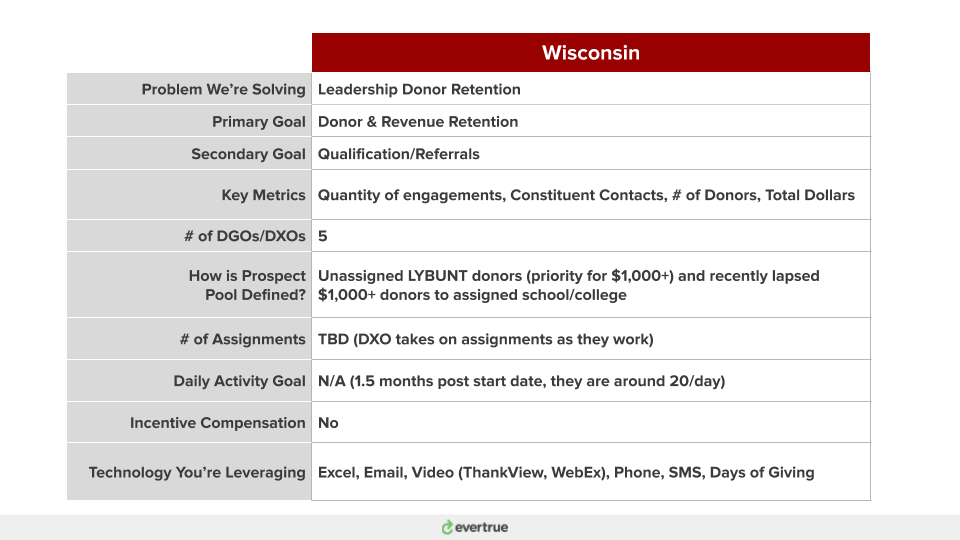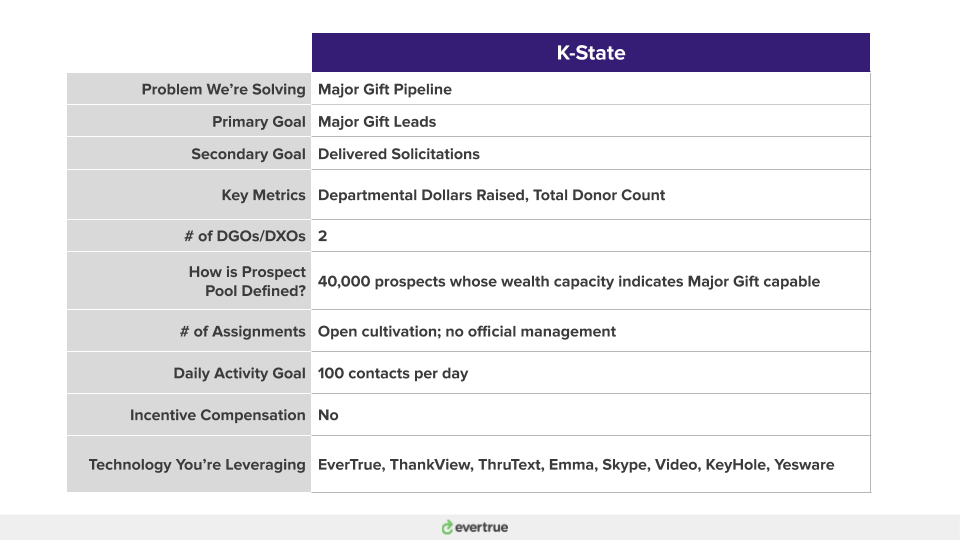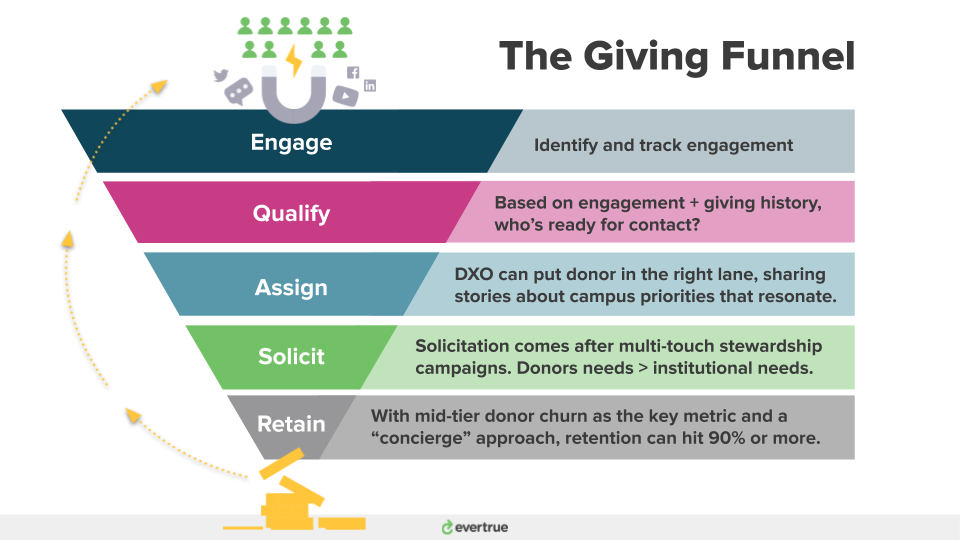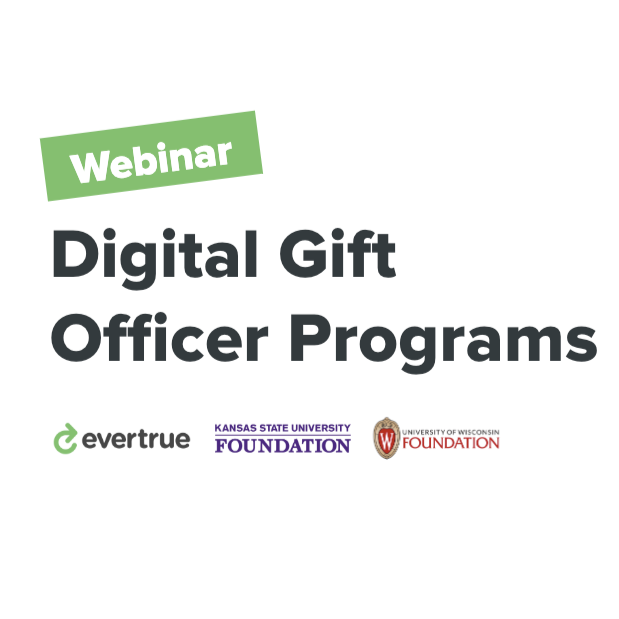Let’s think about your donor experience as an alum.
What if when you gave to your alma mater…
You got a thank-you phone call.
From someone who asked why you gave back and if they could get you more information about that program.
Who then followed up with an email introduction (because, let’s be honest, you definitely let that first call go to voicemail).
They send a video of the students whose experience has benefitted from your gift, which just so happens to coincide with one of the three causes you care about most.
So you take their meeting and have a 10-minute video call. They ask you all about you, what you’re doing now, what you care about, and how you want to be connected with your alma mater.
You hear from this person every other month throughout the year. They send stories connected to everything you shared, the student clubs you were involved in, and about alumni in your area.
You’ve never had a more involved giving experience. Sure, you’re a loyal donor, but it’s not like you’re giving a ton. But here’s someone at the institution you love getting to know you and working to increase your connection.
A year after that first phone call, your new friends calls again to ask if you’ll renew your monthly support and increase your gift.
The answer would be a resounding “YES!” wouldn’t it?
That’s the job of a digital gift officer. They deliver a personalized, concierge-like experience for mid-level donors, helping retain and grow gifts while also identifying donors with the ability and affinity to make major gifts.
And the giving experience they provide stands in stark contrast to what happens when you give to your alma mater now. You get a thank-you call (if you’re lucky), a mailed receipt, and a couple fall foliage postcards asking you to give again next year. That’s pretty much the definition of meh.
How to start and run a digital gift officer program
In yesterday’s webinar, we sat down with two forward-thinking leaders who introduced digital gift officer programs at their institutions this year: Eric Holderness, AVP of Development at the Kansas State University Foundation, and John Grice, Director of Annual Giving for the University of Wisconsin Foundation.
We’re all figuring out this approach as we go, but here’s how these two universities and EverTrue are working on delivering a personal giving experience to high-value donors.
Retention & Reactivation
We don’t talk about donor churn enough.
According to our research, colleges retain about 65% of donors each year. That means they’re losing one out of every three donors.
At a time where participation matters more than ever (thanks US News & World Report), this isn’t good news at all.
The best way to increase participation is to keep the donors you already have.
“We’re trying to connect donor passions with university priorities and it’s all about retention,” John said. “We started with the data and found that leadership annual giving donors are driving the numbers. However, we also saw that we have a challenge in retaining those donors. So if we’re going to move the needle, we need an increased focus on leadership annual giving in our work each year.”

In the for-profit software world, most look at 80% annual customer retention as the bare minimum. At EverTrue, our goal is 95% customer retention.
But retention is really hard if someone gives and then hears nothing until they get asked for another gift. That’s why focusing on retaining the most valuable donors — new ones and regular mid-level donors — by providing a multi-touch, “donor concierge” approach is key. John and his team of five DXOs (donor experience officers) are making that happen.
“We’re really good at the top 1-5% of donor engagement with our major gift officers, but we can improve that experience for mid-level donors,” John said. “It’s hard to get people to give at the leadership annual giving level year after year. That takes personalization. If we can improve retention, that will improve the number of dollars we deliver.”
Want stats to back that up? We’ve got you covered.
According to the Harvard Business Review, a five percent increase in customer retention can increase company revenue by 25-95%.
Major Gift Identification
At Kansas State, their program is structured around identifying major donors. Their digital development officers have a large pool of 40,000 alumni who have $25k+ capacity but aren’t assigned to a frontline fundraiser. They use that as a starting point to prioritize outreach.
By leveraging technology, the DDOs are responsible for up to 100 touchpoints a day each. They use Twitter, Facebook, and LinkedIn to drive engagement and be a part of any K-State discussions online. Then they incorporate video and multi-touch email campaigns to reach out to prospects.
They’re chasing three goals: substantive contacts (conversation via email, social, phone, or video chat), solicitations, and major gift referrals (if they uncover a prospect with high capacity and affinity, they pass those leads to the frontline development officers). This fiscal year, they’ve already passed more than a dozen new leads to gift officers and secured one land grant gift worth more than $1 million.

“We’ve narrowed the prospect pool to people who have the capacity to make a major gift, so that we could deliver that personal experience to this group,” Eric said. “It’s open cultivation. Some of these are people our development officers have met with before and then disqualified. We’re seeing early successes from people who were disqualified in the past, but are now ready to re-engage with a development officer after talking to a DDO.”
Industry-wide donor decline (down 33% in the last 15 years) paired with ever-escalating capital campaigns (the average campaign is now $1B and lasts for nearly nine years) means advancement shops face tapped-out major gift pipelines. But intentional, personal relationship-building with mid-level donors can help supply a steady stream of engaged and motivated prospects to major gift teams.

Want to learn more?
We’ve got the full video from yesterday’s webinar for you (and the slides, too!). During the session, we dig into why these teams got started, a day in the life of a DGO, how to personalize relationships with key donors, and early success stories.
In the coming days, we’ll write more about the tactics, metrics, and hiring strategies Eric and John have put in place (along with EverTrue’s perspective). So make sure you subscribe to the blog and stay tuned.
Thinking about starting your own Digital Gift Officer Program?
We want to help. And we think EverTrue is the best way to do it.
Yeah, we’re biased, but we believe there’s no one else better equipped to help teams retain and grow mid-level donors and identify new major gift prospects.
We give teams the right combination of unique insights like engagement, donor interests, and capacity information, the best, flexible software for managing these programs, and the partnership expertise to make your efforts successful.
We love to talking strategy! Request a demo and we’ll set up a time to brainstorm about your program and see how we can work together.
